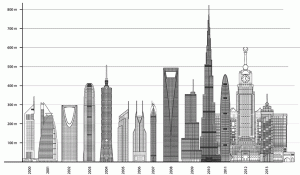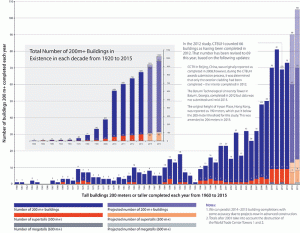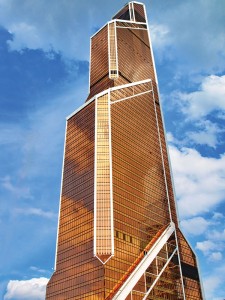By all appearances, the small increase in the total number of tall-building completions from 2012 into 2013 is indicative of a return to the prevalent trend of increasing completions each year over the past decade. Perhaps 2012, with its small year-on-year drop in completions, was the last year to register the full effect of the 2008/2009 global financial crisis, and a small sigh of relief can be let out in the tall-building industry as we begin 2014.
At the same time, it is important to note that 2013 was the second-most successful year ever, in terms of 200-meter-plus (656 feet) building completion, with 73 buildings of 200 meters or greater height completed. When examined in the broad course of skyscraper completions since 2000, the rate is still increasing. From 2000 to 2013, the total number of 200-meter-plus buildings in existence increased from 261 to 830 – an astounding 318 percent. From this point of view, we can more confidently estimate that the slowdown of 2012, which recorded 69 completions after 2011’s record low of 81, was a “blip” and that 2013 was more representative of the general upward trend.
Of course, each year is extraordinary. Here are some of 2013’s key milestones:
- 2013 was the second-most successful year on record for completion of buildings 200 meters or greater in height. In 2013, 73 such buildings were completed, second only to the 81 completions of 2011.
- For the fourth year running, nine supertalls were again completed in 2013. These 36 supertalls total nearly half the total number of supertalls that now exist (77).
- Across the globe, the sum of heights of all 200-meter-plus buildings completed globally in 2013 was 57,946 feet (17,662 meters) – also the second-ranked in history, behind the 2011 record of 71,004 feet (21, 642 meters).
- Of the 73 buildings completed in 2013, twelve – or 16 percent – entered the list of 100 Tallest Buildings in the World.
- For the sixth year running, China had the most 200-meter-plus completions of any nation, at 37 – located across 22 cities.
- The tallest building to complete in 2013 was the 1,165 feet (355-meter) JW Marriott Marquis Hotel Dubai Tower 2 in Dubai, UAE.
- Three of the five tallest buildings completed are in the United Arab Emirates, for the second year in a row.
- The city of Goyang, Korea, has debuted on the world skyscraper stage with eight 200-meter-plus buildings completing in 2013.
- Panama added two buildings over 200 meters, bringing the small Central American nation’s count up to 19. It had none as recently as 2008. Of the 73 buildings over 200 meters completed in 2013, only one, 1717 Broadway in New York, was in the United States.
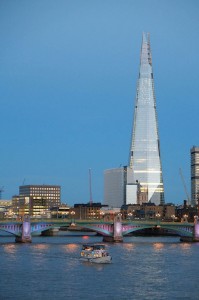
The Shard, London, 1,004 feet, completed 2013. Courtesy of Renzo Piano Building Workshop, William Matthews Photographer.
Key Worldwide Market Snapshots of 2013
Asia
Asia completely dominated the world tall-building industry, at 74 percent of worldwide completions with 53 buildings in 2013, against 53 percent with 35 buildings in 2012. Asia now contains 45 percent of the 100 Tallest Buildings in the World.
China remained the heavyweight and overall undisputed champion of tall-building construction in 2013. A total of 37 two-hundred-meter-plus buildings were completed – 50 percent of the global total – up from 24 in 2012. The sum of heights of all 200-meter-plus buildings in China in 2013 was 29,121 feet (8,876 meters), compared to 19,104 feet (5,823 meters) in 2012, an increase of 52.4 percent.
These buildings were spread across 22 cities. Shenzhen proved to be the most active skyscraper city, doubling its number of completions from the previous year, from two to four. It was closely tailed by Chongqing and Shanghai, which tied at three. Nanjing, Shenyang, Suzhou, Hefei, Tianjin, Nanning, Xiamen and Guangzhou each claimed two completions. Of these, Hefei and Xiamen are first-timers; these cities have never completed buildings of 200 meters or more until 2013.
The tallest building completed in China in 2013 was the 1,089-foot (332-meter) Modern Media Center in Changzhou.
Korea had the next-largest number of tall completions in the Asian region, though its figure of nine buildings was almost entirely due to the opening of an eight-building complex, the Tanhyun Doosan project, whose subtitle, appropriately enough, is “We’ve the Zenith.” Goyang, a city of 1.5 million near Seoul, is now on the world skyscraper map in the same way that so many Chinese cities have entered the world’s consciousness over the past dozen years.
Middle East
As a region, the Middle East recorded completion of 12 buildings of 200-plus meters in height, forming 16 percent of the world total in 2013. This is a decrease from 16 buildings for 24 percent of last year’s total.
While last year’s score was boosted by the completion of the Abraj-al-Bait Endowment, a single seven-building complex in Saudi Arabia, the United Arab Emirates (UAE) remained a dominant player in 2013, increasing from five to 10 completions, a national total second only to China’s. The UAE has been in the top four nations since 2008 and the top three since 2010. For the second year in a row, three of the five tallest buildings completed globally this year are in the UAE.
Dubai laid claim to the title of both the world’s tallest building completion of 2013 , the JW Marriott Marquis Hotel Dubai Tower 2 (1,165 feet, 355 meters), as well as the “world’s tallest twisting tower” – not a category maintained by CTBUH, but impressive nonetheless – with the 1,007-foot (307-meter) Cayan Tower.
Abu Dhabi completed The Gate, whose captivating sky bridge connecting its four towers caught the eye of the 2013 CTBUH Awards Jury which selected it as a Finalist in the Best Tall Buildings Middle East category.
Europe
Europe completed four tall buildings in excess of 200 meters in 2013, and increased its total number of supertalls (greater than 984 feet or 300 meters) in existence from one to three (the first was Capital City Tower in Moscow in 2010). In 2013, Europe also had two buildings (The Shard, London and Mercury City, Moscow) in the world’s 10 tallest completions for the first time since 1953, when two of the seven Moscow “sisters” (MV Lomonosov State University and The Ministry of Foreign Affairs) were completed.
Among the two supertalls to complete in Europe last year was The Shard, which is not only the United Kingdom’s tallest at 1,004 feet (306 meters), but one of the more hard-won victories (anywhere, let alone in the UK) of developer persistence amidst financial crisis, regulatory scrutiny, historic-preservation and traffic-flow constraints.
The 339-meter Mercury City tower put Russia on top of the continent, while the 722-foot (220-meter) DC Tower I brought Austria – which broke the 200-meter threshold only once before with 1999’s Millennium Tower – further into the fold of “European Tall.”
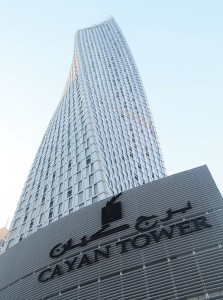
Cayan Tower, Dubai, 1,007 feet, completed 2013.Courtesy of Cayan Group – Real Estate Investment & Development.
The Americas
North America’s share of total 200-meter-plus completions during 2013 dropped from 6 to 1 percent of worldwide figures. Panama comprised the totality of tall buildings completed in Central America in 2013. There were no completions of tall buildings over 200 meters in South America.
Panama continued to punch above its size, completing two 200-meter-plus buildings, the 876-foot (267-meter) Bicsa Financial Tower and the 807-foot (246-meter) Yoo and Arts Tower, both in Panama City. The expansion of the Panama Canal and the appeal of buying real estate on an urban, tropical seashore continued to attract commercial and residential interest to a country that now has 19 tall buildings over 200 meters, but had none as recently as 2008.
In the United States, heavy construction and a slew of new proposals made 2013 an exciting year in New York City, though only one 200-meter-plus building, the 755-foot (230-meter) Marriott Courtyard and Residence Inn Central Park Hotel at 1717 Broadway, was actually completed.
The balance of US interest is in the series of super-slim luxury residential towers now cropping up along 57th Street and in Lower Manhattan; here, slenderness ratios, not pure height, are the object of much discussion. Still, it will be several years before many of these “billionaire needles” are completed.
Tall Buildings in 2013 – by Function
This past year saw the continuation of several trends in building function, which the CTBUH has been tracking over the past decade. These trends are more consistent than the number of completions, which suggests that the story of tall building composition and purpose is at least as interesting, and possibly much more nuanced, than that of pure height and number.
Of the 73 two-hundred-meter-plus buildings completed in 2013, the share of pure office buildings continued to decline, from 39 to 34 percent. Pure-residential functions comprised 30 percent of 2013 completions. Mixed-use buildings ticked up slightly, to 30 percent, up from 29 percent in 2012. Four of the completions were hotels, comprising five percent of the total (against one percent in 2012).
Tall Buildings in 2013 – by Structural Material
Concrete remains the building material of choice for tall buildings globally, holding steady at 63 percent of completions. Composite construction increased from 26 to 32 percent in 2013, while all-steel construction remained a distant third at three percent, a far shot from 1970, when 90 percent of the 100 Tallest Buildings in the World were constructed of steel.
What can we draw from this? It has a lot to do with where construction is occurring and the differing floorplates dictated by multiple uses. Concrete is the leading material in China, for instance, where it is easy to come by, and the lion’s share of activity this past year was in China. A residential or hotel section with compartmentalized apartments might best make use of concrete, with its thick cores, smaller spans and sturdy rigidity. An office section may call for large unobstructed floorplates, which is more easily accomplished in steel. As more mixed-use buildings enter the market, it follows that there is an increasing requirement for mixed construction types within a single building.
Impact of 2013 on the 100 Tallest Buildings in the World
Although this was a very successful year in terms of tall-building completions, it has held close to the average set for the last few years when it comes to the number of skyscrapers of 200 meters or greater to enter the list of the 100 Tallest in the World. In 2013, 12 new buildings entered the 100 Tallest in the World List. In 2012, that number was 13. The all time record since accurate recordkeeping began in 1970 was in 2011, when 18 buildings finished that year entered the 100 Tallest in the World list.
An interesting phenomenon also occurred at the bottom of the 100 Tallest in the World list, indicating just how fleeting the status of tall buildings can be today. Panama’s 932-foot (284-meter) Trump Ocean Club International Hotel & Tower, finished in 2011, entered the 100 Tallest in the World list that year, and was removed in 2013. The Central American nation’s 922-feet (281-meter) Torre Vitri joined Korea’s 932-foot (284-meter) Three International Finance Center in Seoul on the 100 Tallest in the World in 2012; both were out just a year later in 2013.
On the other hand, it took 83 years for the 972.2 foot (282.6-meter) Trump Building at 40 Wall Street (originally the Bank of Manhattan Building) in New York, finished in 1930, to be shown the 100 Tallest in the World exit door in 2013. Its place was well-earned – the last time this building was “trumped” was in 1930, when the “secret spire” of the Chrysler Building pushed 40 Wall Street to the status of “world’s second-tallest” at the very last moment.
Conclusion – And a Look Ahead in 2014
It’s fair to say that 2013 was a year of recovery and a return to the still relatively “new normal” of year-on-year growth in skyscraper completions. While zero megatall (1,969-plus feet; 600+ meters) and nine supertall (300-plus-meters) buildings were completed in 2013 (against one megatall and nine supertalls in 2012), there was no shortage of activity in planning phases, suggesting that the malaise of the global recession may finally have been shaken off in many regions.
In 2014, we predict between 65 and 90 buildings of 200 meters or more will be completed. This year will no doubt be an exciting one, and a year of continued growth. Here is some of what’s in store:
- Up to 13 of the scheduled completions in 2014 will be supertalls (300 meters or higher).
- The Torre Costanera, at 984 feet (300 meters), will be South America’s tallest building and its first supertall.
- Twisting towers will continue to enter the vanguard of tall in 2014 – the KKR2 Tower of Kuala Lumpur, Malaysia, and the Spine Tower of Istanbul, Turkey, lead the list.
- A typically curvaceous Zaha Hadid-designed tower, the Wangjing SOHO T1, will complete in Beijing, China this year. This building was the subject of piracy rumors early last year when a highly similar tower group, the Meiquan 22nd Century in Chongqing, was revealed. The race is on in earnest to see if the original finishes before the “copy.”
- The China Broad Group’s Sky City J220, an (828-meter), 220-story building to be constructed entirely of prefabricated modules, may or may not have gotten underway, according to conflicting reports, and may or may not complete in 2014. Either way, the world will be watching. Unshaken by skeptical peers, the media and bureaucratic hurdles, Broad Group Chairman Zhang Yue has vowed the project – aiming to become the world’s tallest before Kingdom Tower takes the title – will continue.
- One World Trade Center, New York, when it completes in 2014 at its intended symbolic 1,776 feet (541 meters), the building will gain status as the United States’ and North America’s tallest building.
- The first of the crop of “superslim” towers in Midtown Manhattan, New York City, the 1,004-foot (306-meter) One57, will complete, upping the ante for its even-slimmer rivals along 57th Street.
About CTBUH
The Council on Tall Buildings and Urban Habitat is the world’s leading resource for professionals focused on the design, construction, and operation of tall buildings and future cities. A not-for-profit organization, founded in 1969 and based at the Illinois Institute of Technology Chicago, the group facilitates the exchange of the latest knowledge available on tall buildings around the world. The Council also maintains the world’s largest free database on tall buildings, The Skyscraper Center. The CTBUH also developed the international standards for measuring tall building height and is recognized as the arbiter for bestowing such designations as “The World’s Tallest Building.”▪
The authors gratefully acknowledge research assistance by Marty Carver and Marshall Gerometta of CTBUH.


